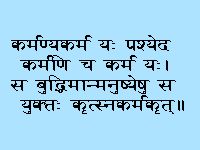Yoga
AYURVEDA CONCEPT OF RASAYAN THERAPY

( ayurveda4uall’s Photos – ALL India confrence Delhi 7-8 Oct )
Rasayan, a Sanskrit word (with literal meaning: Path (ayana) of the Juice (rasa), or Elixir vitae), is used to describe chemistry and alchemy, and chemistry is generally called Rasayan Shastra in Sanskrit,Nepali, Marathi, Hindi, Kannada and several other languages. Ancient rasayan texts center around the use of prepared forms of mercury (see samskaras), as do occidental alchemical texts. However, there is also ample mention of the preparation of medical tinctures in the ancient science of rasayan; rasayan is in fact a part of Ayurveda. Read more: > HERE <
Concept of Rasayana Therapy
Rasayana Tantra is one of the eight major divisions of Astang Ayurveda. In Ayurveda, one of the major methods of presentation of positive health has been described i.e. Rasayana.
Sushruta has defined a healthy man as one who has:-
• Equilibrium of the Doshas Sama dosha.
• Normal functioning of Agni Sama Agni
• Normal condition of 7 Dhatus Sam Dhatu
• Normal Excretion of waste products Sam Malkriya.
Beside this Atma (Soul), the Indriyas or sense organs and Mana or mind should be happy and cheerful Prasanatamendriya Mana (Su.Su.15/15). The current modern definition of health is also same “Health is a state of complete physical, mental and social well being and not merely absence of disease. (W.H.O.)
Healthy state of mind and body can be achieved by Rasayana Therapy or Rejuvenation Therapy
Rasayana Stands as an answer to solve the problem of healthful longevity including mental development and resistance against disease. That is why; Rasayanatherapy has been included as one of the eight major divisions of Ashtang Ayurveda. Rasayana Chikitsa or rejuvenation therapy helps to promote and preserve health and longevity in the healthy, and to Cure disease in sick. We all want to look forever young and increase our life span by staying healthy, Rasayans or vitalizers, as they are called, do exactly the same. They replenish the vital fluids of our body, thus keeping us away from diseases. Rasayana refers to the nutrition and its transportation in the body. Such a state of improved nutrition is claimed to lead to a series of secondary attributes like longevity, immunity against diseases, mental competence and delaying of aging.
Rasayana is actually that which increases the essence of each Dhatu, starting from Rasa. Taking Rasayana is helpful to increase the immunity of person to keep him away from diseases. The person become healthy and strong .Literally the term Rasayana refers to the means of obtaining the optimum nourishment to the Dhatu.
Meaning of Rasayana
The word Rasayana is composed of two words Ras + Ayan. The means by which one gets the excellence of Rasa (The nourishing fluid which is produced immediately after digestion) is known as Rasayana. Apart from the excellence of Rasa, the individual is endowed with Psychic excellence like sharp memory, by virtue of rejuvenation therapy. The term Rasayana connotes a specific meaning. Drugs, diet and regimens which promote longevity by delaying aging and preventing diseases are called Rasayana. The term Rasa has different connotation. In the present context, it means the body fluid which is responsible for nourishment of entire physique. Impairment of circulation of this body fluid results in diseases and decay. This body fluid of good quality should not only be present in adequate quantity, but also it should be able to permeate (circulate) throughout the various cells of the body to provide the type of nourishment they need.
Rasayana is a specialized type of treatment influencing the fundamental aspect of body viz. Dhatus, Agni and Srotansi and ojus etc. Rasayana Chikitsa boosts theojus and immune system. The adjective Ojaswiis used to describe those people who keep good health in all seasons and all stages of life. It is like obtaining a high rank in a physical or mental fitness. Ojus gives a bright look, sharp memory, high performance and every expected pleasure.
Historic Consideration of Rasayana
Rasayana therapy is as old as the Vedas because many references on Rasayana therapy are available in the Atharva Veda (atharvaveda 8/7/4). Extensive descriptions of divine Rasayana agents like Soma are available in classics. References about Achara Rasayna and Sadvrita are also available in the vedic texts similar to Charakadescription (Rig-Veda 5/1/7 and Atharvaveda 16/2/2)
Besides extensive references is available regarding the superiority of certain other common Rasayana drugs like Pippali, Jivanti and Punarnava etc. Similarly a concept of Ajasrika Rasayana also appears in vedic literature.
Vedas have seriously considered the problems of aging and its delaying. It has been the cherished wish of human race to achieve long life and to live at least 100 years in perfect health. “Jivema Sharadah Shatam” (Rigveda 10/39/8).
Probably all these ideas at a later stage necessitated the development of a full-fledged clinical discipline like Rasayana therapy to deal with the problem of aging, its delaying.
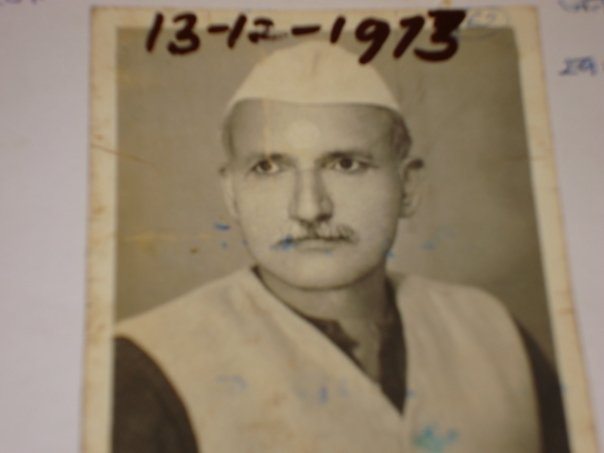
…my beloved grandfather who was also great vaidya . ( Ayurvedic doctor ) had open ayurveda college in 1970´s then then he moved to noida near to delhi on speical invitation of his holiness maharishi ji and worked 20yrs in maharishi Ayurveda.
vaidya adwait tripathi
Arogya sadnam
H-129, Sector-41
Noida-201302
On call special appointment can fix for patient for Free Pulse diagnose ..
> MEET AYURVEDA4UALL… AT FACEBOOK. <
> Dein Ayurveda Net: ….. > Ayurveda, Ursprung, Geschichte <
> Dein Ayurveda Net: ….. > Jahreszeiten im Rythmus, Bioenergien <
> Meet Herbals and Naturals and friends at facebook <
> Meet all Ayurveda Groups, Friends, Studies at facebook <
> Meet Lord Dhanvantri at facebook <
GLORY´s and THANK´s. READ FULL ARTICLE:
YOGA & DANCE – Hasta Mudra Project
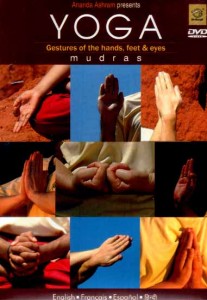
> LIFE POSITIVE – Gracefull Gestures <
> GESTURE´s IN WESTERN CHRISTIANITY <
A mudrÄ� [muːˈdrɑː] (help·info) (Sanskrit: मुद्रा, lit. „seal“) is a symbolic or ritual gesture in Hinduism and Buddhism. While some mudrÄ�s involve the entire body, most are performed with the hands and fingers. A mudrÄ� is a spiritual gesture and an energetic seal of authenticity employed in the iconography and spiritual practice of Indian religions and traditions of Dharma and Taoism. Read more: > HERE <
The Hasta Mudra Project
A Collaboration of Tanjore Performing Arts and Chocolate Media.
The presentation of research and documentation included on this website is only the beginning of a larger project that will unveil connections between the use of hasta mudras in various traditional healing and performing arts and linking them to modern day usage today. The ultimate goal is to develop a documentary film that is visually pleasing and yet offers depth of research and content into the subject matter. Achieving this requires travel to India and other destinations where video footage will be shot on location at various temples and sites, interviews of scholars and practitioners around the world, as well as a variety of technical equipment and expertise.
The content within this website is derived of excerpts from an ongoing research project on hasta mudra as they are utilized in Bharata Natyam classical dance of India. The literal translation of the Sanskrit hasta mudra is hand (hasta) symbol (mudra), though hasta mudra can be interpreted in English as hand gestures or sign language. The broader scope of this project encompasses the ancient art of hand symbols as found in all the arts, including fine arts, performing arts, ritual arts, and healing arts.
Drawing connections within movement and myth, life and art, this project aims to provide insight into the world of hand symbolism through examining written and visual examples. We start with a brief historical overview and then proceed to analyze the usage of hasta mudras in dance. Technical nuances in their significance are examined as well as important artistic and stylistic qualities. This study’s analysis is offered from the point of view of an experienced practitioner of the art and is supported by several ancient texts, lending it both a personal as well as scholarly perspective.
Please consider being a part of this valuable project by contributing your expertise or funds. The project is in need of seed money to take it off the ground and into the next phase of production. If you have suggestions or would consider including this project into your funding or research plans, please contact us.
Anu Naimpally or Russ Smith
> Meet Hinduism Friends, Groups, Studies at fb <
> Meet Buddhism Friens, Groups, Studies at fb <
> Meet Taoism Friends,Groups, Studies at fb <
> Meet Bible Friends and Studies at fb <
> Meet orthodox Church Friends, and Studies at fb <
DIE AUTOBIOGRAPHIE EINES YOGI´s
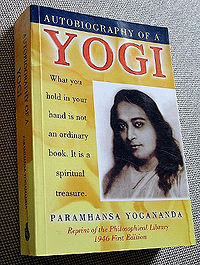
> PARAMAHANSA AND KRIYA YOGA <
> UNESCO, PURANAS, KRIYA YOGA <
> GUIDANCE ON THE ECONOMIC CRISES <
> PARAMAHANSA´s VIEW ON THE 4 GOSPEL´s <
> INTERNATIONAL HEADQUATER BUILDING <
Paramahansa Yogananda (Bengali,Pôromohôngsho Joganondo, Sanskrit: परमहंस योगानंद Paramahaṃsa YogÄ�naṃda; January 5, 1893–March 7, 1952), born Mukunda Lal Ghosh (Bengali:, Mukundo Lal Ghosh), was an Indian yogi and guru who introduced many westerners to the teachings of meditation and Kriya Yoga through his book, Autobiography of a Yogi. Read More: > HERE <
In 1946, Paramahansa Yogananda (January 5, 1893–March 7, 1952), published his life story, Autobiography of a Yogi, which introduced many westerners to meditation and yoga. It has since been translated into 25 languages, and the various editions published since its inception have sold over a million copies worldwide. The book describes Yogananda’s search for a guru, and his encounters with leading spiritual figures such as Therese Neumann, the Hindu saint Sri Anandamoyi Ma, Mohandas Gandhi, Rabindranath Tagore, Nobel Prize-winning physicist Sir C. V. Raman, and noted American plant scientist Luther Burbank, to whom it is dedicated. Read more: > HERE <
Paramahansa Yogananda – Wissenschaftliche Heilmeditationen:
Schon lange bevor Heilmeditationen in solch unterschiedlichen Bereichen wie Krankenhäusern und in der Rehabilitation, im Sport und in den Büros der Manager breite Anwendung fanden, hatte der berühmte Mystiker Paramahansa Yogananda durch sein umfassendes Verständnis die tiefgeistigen Grundlagen gelehrt, welche diese althergebrachte wissenschaftliche Methode so außerordentlich wirksam machen.
In diesem Buch enthüllt er die verborgenen Gesetze, die man sich zunutze machen kann, um seine Gedankenkraft konzentriert einzusetzen – nicht nur um den Körper zu heilen, sondern auch um Hindernisse zu überwinden und sein Leben erfolgreich zu gestalten. Dieser Band enthält neben ausführlichen Anleitungen Heilmeditationen verschiedener Art: zur Heilung des Körpers, zur Entwicklung von Selbstvertrauen, zur Erweckung von Weisheit, zur Überwindung schlechter Gewohnheiten – und zu vielen anderen Zwecken.
-
143 Seiten, Paperback:
-
www.yoga-aktuell.de : > DIE WISSENSCHAFTLICHEN HEILMETHODEN <
> Meet Paramahansa Yogananda friends, groups, studies at fb <
PREM NIRMAL: TRIPURA RAHASYA RETREAT

www.sriramanasevaashram.blogspot.com
TRIPURA RAHASYA RETREAT
The Mystery beyond the Trinity
www.premnirmal.com
Tripura Rahasya was considered by Bhagavan Sri Ramana Maharshi as one of the greatest works that expounded advaita philosophy. He often quoted from it and regretted that it was not available in English. As a consequence Sri Munagala Venkataramaiah (now Swami Ramanananda Saraswathi) took up the work of translation in 1936 as another labour of love, adding just one more English translation to his already extensive store. This was first published in parts in the Bangalore Mythic Society’s Journal (Quarterly) from January 1938 to April 1940 and afterwards collected into book form, of which five hundred copies were printed and privately circulated. The Asramam has since taken over the copyright and made it one of their official publications.
Mahavidya in Hinduism, Shaktism: > Here <
DATTATREYA UPANISHAD: > Here <
Tripura Rahasya was considered by Bhagavan > Sri Ramana Maharshi < as one of the greatest works that expounded > Advaita philosophy <. Tripura literally means the three cities. They are the states – Jagrat (waking state) – Svapna (dream state) and Shushupti (deep sleep state). The undercurrent of consciousness in all of them, remaining unaffected, is metaphorically called the Resident Mistress by name of > Sri Tripura < . The procreative faculty generating new beings and the link of altruistic love connecting the offspring to the parent are personified in the Mother; hence the feminine termination of Tripura. „The way to transcendence“ signifies that interest in Tripura purifies the mind and creates the zeal for enquiry into the Truth. As in many of the Great Indian texts, the presentation is that of a dialogue between Master (Dattatreya) and Disciple (Parasurama). The latter conveys his doubts, one after another to His Master who responds patiently with clarity and using as great a variety of explanations as the quantity of doubts thrown at him. Slowly but surely, He destroys his Disciple’s every doubt and misconceptions thus revealing the Truth beyond all states: the Stateless State.
During this retreat we will practice Chakrodaya Dhyan with sandhikal jagrukta, Suprashant Pranayam, Nirmal Kriya with Nirmal Mudra to dive deep in Meditation to explore the unknown and unknowable. Also we will have many insights form Tripura Rahasya to contemplate! Because of the intensive nature of this retreat, no. of participants is limited to a small group. Entry to this camp is on first come first serve basis. Senior citizens having problems of movement will be given rooms on ground floor near conference room.
This retreat is an ideal combination “Dhyan – Gyan – Bhakti” (Meditation – Understanding – Devotion) that will help you to settle your understanding of the process of Enlightenment and Ascension. We will practice various methods of meditation and contemplation to internalize Tripura Rahasya that will help you to sustain enlightenment. Please note that this retreat is only for those who have a strong desire to learn, grow and walk the path to sustained enlightenment. Those who have attended ADP Camp and /or have background of Kashmir Shaivism are most welcome.
Please note that there are no eligibility criteria for this camp. All sincere seekers of truth who are ready to dive deep within and explore the unknown are welcome. Those seekers who had Satori experience or Enlightenment experience in past are welcome to learn further on how to sustain the enlightenment.
This retreat will be personally conducted by Guruji Prem Nirmal. To know more about Guruji explore www.premnirmal.com
To register for this event, ask for the registration form and detailed leaflet by mail to pdnirmal@gmail.com for any further help Call 09769543111
> Meet Ramana Maharshi Groups, Friends, Studies, Fans at facebook <
> Meet Hinduism, Groups, Friends at facebook <
> Meet Kashmir Hinduism, Studies, Friends at facebook <
> Meet Shaktism and Devi the Godess at facebook <
> Meet Saundaryalahari: Wave of Bliss by Shankaracharya at fb <
> Meet Arsha Vidya Gurukulam, Studies, Friends, Fans, at fb <
> Meet Advaita Vedanta,Groups,Friends,Studies, Vivekananda at fb <
> Meet Prem Nirmal and Friends at facebook <
> Meet Sri Ramana Maharshi Seva Ashram at facebook <
SRI RAMANA MAHARSHI, HERBAL MEDICINE
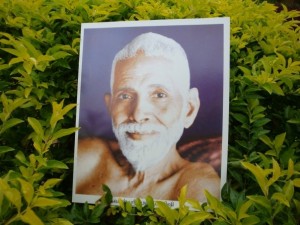
> DOWNLOADS, BIOGRAPHY, MEDICINAL RECIPES <
> DR. V. MANICKAM – SRI RAMANA HERBS <
Sri Ramana Maharshi (Tamil: ரமண மஹரிஷி) (December 30, 1879 – April 14, 1950), born Venkataraman Iyer, was an Indian sage. He was born to a Tamil-speaking Brahmin family in Tiruchuzhi, Tamil Nadu. After having attained liberation at the age of 16, he left home for Arunachala, a mountain considered sacred by Hindus, at Tiruvannamalai, and lived there for the rest of his life. Arunachala is located in Tamil Nadu, South India. Although born a Brahmin, after having attained moksha he declared himself an „Atiasrami“, a Sastraic state of unattachment to anything in life and beyond all caste restrictions.
Sri Ramana maintained that the purest form of his teachings was the powerful silence which radiated from his presence and quieted the minds of those attuned to it. He gave verbal teachings only for the benefit of those who could not understand his silence. His verbal teachings were said to flow from his direct experience of Consciousness as the only existing reality. When asked for advice, he recommended self-enquiry as the fastest path to moksha. Though his primary teaching is associated with Non-dualism, Advaita Vedanta, and Jnana yoga, he recommended Bhakti to those he saw were fit for it, and gave his approval to a variety of paths and practices. Read more: > Here <
Bhagavan Ramana and Herbal Medicine
By Dr Manikkam
The essence of all beings is earth. The essence of earth is water. The essence of water is the herb. The essence of the herb is the human being. So says a maxim of the Chandogya Upanishad.
The health traditions of India extend to thousands of years. It perhaps started with the cave man who consumed roots, leaves and herbs raw before discovering fire and subsequently the means of cooking. In this, however, man was only imitating the animals which consumed plants to alleviate health disorders. Nature has provided animals with hindsight that helps them recognise symptoms of bodily disorders, the means of selfdiagnosis and self-medication. The monkey provides one of the most common and best examples. To this, we shall revert later. In India, before codified medicinal systems like Ayurveda and Siddha took roots, folk curative traditions based on observation and experimentation were developed and nurtured.
This tradition had its variants in accordance with climate, terrain and habits; but the essence was the same. The plant kingdom was considered the saviour. General health disorders were treated by a combination of various plants and herbs. Each and every part of a plant was useful root, bark, stem, leaf, flower, fruit and seed. Methods were developed to extract the maximum benefits from each of the parts of a plant. This glorious tradition which was the forerunner to Siddha and Ayurveda, was passed through word of mouth to successive generations. The grandmother in the house was the main custodian of this oral tradition. Proverbs were created and repeated any number of times by the elders in the family to emphasise the importance of healthy living, both physical as well as mental. These proverbs have stood the test of time and they remain intact to guide us. The properties and benefits of herbs and plants were enshrined in easy to understand language.
All Indian languages had their own variants of these health proverbs. The most important feature of the ancient Indian systems of medicine is to look at the human being as a whole entity. The physiological part of it was not divorced from the psychological and the psychical. The body, mind and soul were not treated separately, but as constituting a wholesome single entity. Ancient puranic tradition has it that this system was practised by the rishis, siddhas and devas, the celestial beings. The siddhas were seekers after God. It was they who scientifically developed and nurtured various disciplines such as yoga, medicine, linguistics and other allied arts and sciences.
FULL TEXT ABOUT HERBAL SYSTEM, MEDICINE, RECIPE´s and more: > HERE <
Dr. Manickam and his family are very humble devotees of Bhagavan. His tradition is ‚Herbal Medicine‘, which combines Herbal remedies with the Ayurvedic and Siddha systems of medicine using modern diagnostic techniques. He uses and researches some of the medicinal recipes created by Bhagavan Sri Ramana Maharshi, plus those of his father and grandfather.
All of Bhagavan’s recipes replace the more traditional Ayurvedic ones with pure herbal formulae, which have been found by doctor Manickam to have many times the potency and effectiveness of the traditional recipes. They also have no known side-effects.
All of Bhagavan’s recipes use herbs found on and around Arunachala, this of course adds priceless value to those recipes.
Anyone suffering from ailments and not happy with Western treatments can contact Dr. Manickam at the address and telephone number below …..
Dr. V. Manickam
Sri Ramana Herbs
54-c Mathalangula Street
Tiruvannamalai – 606 601
Tamil Nadu
South India
-
Telephone: (0091) 4175 251937 – NEW Telephone number
- Email – Dr Manickam <drmanickam_tvm@sify.com> – NEW E-mail address.
-
Dr. Manickam is a registered practitioner … Reg. No. 10327 (H)
Tiruvannamalai Charities Supported by This Site:
The three charities listed below have been thoroughly checked by myself and all are genuine.
Ramana Maharshi Rangammal Memorial Hospital and School – 1.4 Mb
Shanthimalai Research & Development Trust – 1.0 Mb
Sanmarga Dayasramam Trust – 1.4 Mb
> Meet Ramana Maharshi Groups, Friends, Studies, Fans at facebook <
> Meet Sri Ramana Seva Ashram,Rachapalli at facebook <
> Meet Herbals & Naturals at facebook <
> Meet Arsha Vidya Gurukulam, Studies, Friends, Fans, at fb <
> Meet Advaita Vedanta,Groups,Friends,Studies, Vivekananda at fb <
PRIME TREATMENTS IN AYURVEDA
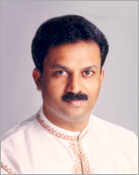
Dr. E. Shaji Raj, www.punarjanis.com
> PRIME TREATMENTS IN AYURVEDA <
Centuries ago, the enlightened masters, in search of spiritual solace, composed the Ayurveda, for the welfare of humanity. According to the scriptures, the human body is made up of 72000 channels connected to the seven spiral energy centers, the diseases of body and mind, which in turn block the path to spiritual enlightenment. The Panchakarma treatment aims at cleansing these channels, pacifying the disease and nourishing the body. It provides longevity, immunity against the disease, whereas in ancient times Yoga, Astrology, Tantra, and Ayurveda were practiced not for longevity but as an ultimate path to enlightenment.
In those ages Ayurveda and self-realisation were cognate and the people held this science in veneration. In the present world it is seen as merely a tool to cure human ailments. More over the practitioners of Ayurveda were Yogis, who would hold the stretched arms of the patients in their hands locate the pulse points and close their eyes as if in a deep trance. Seconds later, they would recount the diagnostic findings one by one. They never had any clinical laboratory or any other technological devices. The innate propensity of certain punarjanis were so splendid that it could work wonders to cure the diseases.
The physician:
Inspired by the findings of the Ayurveda masters we have formulated a system of treatment at ‚Punarjanis‘ bringing the ancient teachings to the limelight in an attempt to serve humanity. We focus on patients with chronic intractable ailments where routine medicine is only palliative.
Dr. E. Shaji Raj, a disciple of Bhramashri Parabattaraka Ananganandanathan Padathirtha, completed his > BAMS < from Madras University. Hailing from a family of traditional Ayurvedic physicians, he has been doing active research in the field of healing for the past 16 years – primarily related to raising energy from the lower center of the body to the higher center. He is one among the few ayurvedic physicians around the world who practice pulse reading and panchakarma treatment.
Incorporating the philosophy and the gist of Ayurveda with the root idea of Tantra and Yoga, the final result is not just cure, but a sea change – a path to enlightenment and bliss. The results have been amazing – an enlightened mind in a sound body.
Adi Shankara:
Adi Shankara (Malayalam:ആദി ശങ്കരന്, DevanÄ�garÄ�: आदि शङ्कर, Ä�di Śaṅkara, pronounced [aːd̪i ɕaŋkərə]); (788 CE – 820 CE), also known as Śaṅkara BhagavatpÄ�dÄ�cÄ�rya and Ä�di ŚaṅkarÄ�cÄ�rya, was an Indian philosopher who consolidated the doctrine of Advaita Vedanta, a sub-school of Vedanta. His teachings are based on the unity of the soul and Brahman, in which Brahman is viewed as without attributes. He hailed from Kalady of present day Kerala.
Shankara travelled across India and other parts of South Asia to propagate his philosophy through discourses and debates with other thinkers. He founded four mathas („monasteries“), which helped in the historical development, revival and spread of Advaita Vedanta. Adi Shankara is believed to be the organizer of the Dashanami monastic order and the founder of the Shanmata tradition of worship.
His works in Sanskrit, all of which are extant today, concern themselves with establishing the doctrine of Advaita (Nondualism). He also established the importance of monastic life as sanctioned in the Upanishads and Brahma Sutra, in a time when the Mimamsa school established strict ritualism and ridiculed monasticism. Shankara relied entirely on the Upanishads for reference concerning Brahman and wrote copious commentaries on the Vedic Canon (Brahma Sutra, Principal Upanishads and Bhagavadgita) in support of his thesis. The main opponent in his work is the Mimamsa school of thought, though he also offers some arguments against the views of some other schools like Samkhya and certain schools of Buddhism that he was familiar with.
Read More here : > HERE <
> Meet all Ayurveda Friends, Groups, Studies at facebook <
> Meet all Buddhism Friends, Groups, Studies at facebook <
> Meet all Hinduism Friends, Groups, Studies at facebook <
> Meet FREE visa to india for MBA , degree Programs, it jobs at fb <
> Meet Vedanta Studies, Friends, Yoga, Int. Society, Groups at fb <
TRADITIONAL ISLAMIC MEDICINE
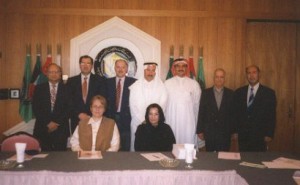
> Medicine in medieval Islam <
> ISHIM Society for Islamic Medicine <
In the history of medicine, Islamic medicine or Arabic medicine refers to medicine developed in the medieval Islamic civilization and written in Arabic, the lingua franca of the Islamic civilization. Despite these names, a significant number of scientists during this period were not Arab. Some consider the label „Arab-Islamic“ as historically inaccurate, arguing that this label does not appreciate the rich diversity of Eastern scholars who have contributed to Islamic science in this era.[1] Latin translations of Arabic medical works had a significant influence on the development of modern medicine, as did Arabic texts chronicling the medical works of earlier cultures.
The International Society for the History of Islamic Medicine
There is a consensus amongst researchers of the history of medicine that early Arab and Muslim physicians had played a very important role in the development of medical science during the renaissance of Islamic civilization, which spanned for eight centuries. This was achieved through translating earlier medical and scientific scripts and developing these sciences in the light of their clinical expertise.
Despite the above fact, it is well-known that, as yet, the full potential of the Islamic medical heritage has not been investigated in a way that shows its real role and importance in the development of modern medicine; especially its effect on the European Renaissance. So far, only a little part of this important heritage has been studied or come to light. Most of the scripts of Islamic medicine are dusting on the shelves of private and some public libraries around the world.
In the light of this, a number of physicians, scholars and historians called for reviving this heritage on an international level. This is to be achieved through organization and teamwork. And this is how the idea of the International Society for the History of Islamic Medicine emerged.
The first meeting of this society convened between 1-3 December 2000 in Doha (QATAR) and was chaired by HE Dr.H.A.Hajar Al-Binali, Minister of Health in Qatar. A number of physicians and historians have attended this meeting.
> Meet Islamic Medicine, Cure, Friends, Hospital at facebook <
> Meet Saint Kabir, Bhakti, Friends at facebook <
> Meet Saint Rumi, Friends, Studies at facebook <
TRADITIONELLE MEDIZIN IN EUROPA
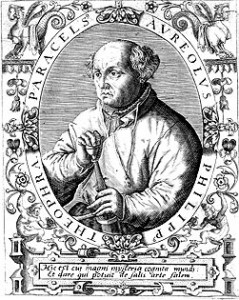
> TRADITIONAL GREEK MEDICINE <
Paracelsus (born Phillip von Hohenheim, 11 November or 17 December 1493 in Einsiedeln, Switzerland – 24 September 1541 in Salzburg, Austria) was a Renaissance physician, botanist, alchemist, astrologer, and general occultist. Born Phillip von Hohenheim, he later took up the name Theophrastus Philippus Aureolus Bombastus von Hohenheim, and still later took the title Paracelsus, meaning „equal to or greater than Celsus“, a Roman encyclopedist, Aulus Cornelius Celsus from the first century known for his tract on medicine.He is also credited for giving zinc its name, calling it zincum and is regarded as the first systematic botanist
GERMAN PHYSICIAN, ALCHEMIST, AND SCIENTIST
1493–1541
Paracelsus was born Theophrastus Bombastus von Hohenheim.
He was a contemporary of Martin Luther and > Nicolaus Copernicus <. He adopted his pseudonym based on his assertion that he was a better physician than Celsus, the first century C.E. Roman author on medicine acclaimed in Renaissance Europe (he was „Para-Celsus,“ or beyond Celsus).
His self-promotion as „The Most Highly Experienced and Illustrious Physician … “ has given us the word „bombastic,“ derived from his birth name.
Paracelsus gained his early medical knowledge from his father, who was a physician. He followed this education with formal medical training at the University of Ferrara in Italy. Finding his formal training disappointing, Paracelsus embarked on a life of travel and study combined with medical practice. According to Paracelsus, he collected medical knowledge anywhere he could find it without regard to academic authority.
He acknowledged his consultations with peasants, barbers, chemists, old women, quacks, and magicians. Paracelsus developed his notions of disease and treatment away from any established medical faculty and promoted the idea that academic medical training had reached a state deeply in need of reform.
Paracelsus believed in the four „Aristotelian“ elements of earth, air, fire, and water. His medical theory was based on the notion that earth is the fundamental element of existence for humans and other living things. Paracelsus believed that earth generated all living things under the rule of three „principles“: salt, sulfur, and mercury. He therefore believed these substances to be very potent as chemical reactants, as poisons, and as medical treatments. Read More about Aristoteles: >HERE <
THE AGAMIC TRADITION AND THE ARTS – (tantrah.)
Mahabhutas in Sangita-Sastra
With Special Reference to Yoga and Ayurveda
Prem Lata Sharma
The five elements have been said here to be the manifestation of Siva, the Supreme Being.
An enquiry into the role of Mahabhutas in Music is essentially a quest for the relationship between the ‚outer‘, ‚inner‘, and what is beyond the two. Roughly, the human organism is the ‚inner‘, whatever is outside the body is the ‚outer‘ and both are closely interrelated.
That which permeates both of them and is yet intangible is beyond them. In understanding the ‚inner‘, both Yoga, and, Ayurveda have made a deep study of the psycho-physical centres in the human body as well as the physiological structure of the body in terms of the Mahabhutas.
The unity of the ‚inner‘ and the ‚outer‘ has been established by expounding that the sense-organs, their objects and their functions are all manifestations of the Mah¡bh£tas. The following passage from Sa´g¢ta-Ratn¡kara makes this very clear.
The Sangita-Ratnakara (1.2.56c-71b) describes the structure and functions of the human body in terms of the five Mahabhutas as follows: >>> H E R E <<<
RAJA DEEKSHITHAR: ( http://rajadeekshithar.com/ )
…“ Education: Proposed PhD on the Panca Mahabhuta or Primordial Elements in Indian Traditions under Professor Dr.Ria Kloppenborg of the Department for Religious Studies, Faculty of Theology of the University of Utrecht in The Netherlands. This PhD could not be completed because of the untimely passing away of Professor Kloppenborg (2002-2004)…“
“ The mahabhutas in cidambaram and ancient temples „
GROSS ELEMENTS IN YOGA, AYURVEDA, HINDUISM, BUDDHISM:
MahÄ�bhūta is Sanskrit and PÄ�li for „great element.“ In Hinduism, the five „great“ or „gross“ elements are ether, air, fire, water and earth. In Buddhism, the „four great elements“ (Pali: cattÄ�ro mahÄ�bhūtÄ�ni) are earth, water, fire and air.
In Hinduism’s sacred literature, the „great“ or „gross“ elements (mahÄ�bhūta) are fivefold: space (or „ether“), air, fire, water and earth.
For instance, the TaittirÄ�ya Upaniṣad describes the five „sheaths“ of a person (Sanskrit: puruṣa), starting with the grossest level of the five evolving great elements:
From this very self (Ä�tman) did space come into being; from space, air; from air, fire; from fire, the waters, from the waters, the earth; from the earth, plants; from plants, food; and from food, man…. Different from and lying within this man formed from the essence of food is the self (Ä�tman) consisting of lifebreath…. Different from and lying within this self consisting of breath is the self (Ä�tman) consisting of mind…. Different from and lying within this self consisting of mind is the self (Ä�tman) consisting of perception…. Different from and lying within this self consisting of perception is the self (Ä�tman) consisting of bliss….
In Buddhism, the four Great Elements (Pali: cattÄ�ro mahÄ�bhūtÄ�ni) are earth, water, fire and air. MahÄ�bhūta is generally synonymous with catudhÄ�tu, which is PÄ�li for the „Four Elements.“ In early Buddhism, the Four Elements are a basis for understanding and for liberating oneself from suffering. They are categories used to relate to the sensible physical world, and are conceived of not as substances, but as sensorial qualities.
In the Pali canon, the most basic elements are usually identified as four in number but, on occasion, a fifth and, to an even lesser extent, a sixth element may be also be identified.
Read Full Text: > HERE <
> Verzeichnis Naturheilkunde, Verbände, Organisationen <
> Meet All Herbal Studies, Groups, Friends, Fans at Facebook <
> Meet Paracelsus at facebook <
> Meet Aristoteles at facebook <
VEDA, VEDIC SCIENCES, PANCHANGAM
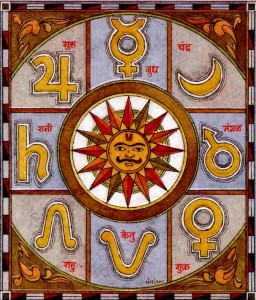
www.astrojyoti.com www.vaisnavacalendar.info
> Hindu astrological almanac <
WHAT IS PANCHANGAM ?
Tamil panchangam, Telugu Panchangam, Kannada Panchangam, Gujarati Panchangam, Marathi Panchangam, Hindi Panchangam, Benglai Panchangam or whatever panchangam you call it. Panchangam means five attributes of Hindu calendar day that is Tithi, Vaar, Nakshatra, Yoga, and Karana.
It is the official astrological calendar of practicing Hindus. It forecasts celestial phenomena such as solar eclipses as well as more mundane occurrences. The study of Panchangam involves understanding Rasi phala, the impact of the signs of the zodiac on the individual. Astrologers consult the Panchangam to set dates for weddings, corporate mergers, and other worldly activities.
These panchangam elements are same across all panchangam — Tamil panchangam, Telugu panchangam, Malayalam panchangam, and Hindi, Gujarati, Marathi, Punjabi, and other panchangam. What is different is how they threat their months/year. Solar months and their starting rules and luni-solar moths. Tamil, Malayalam, Bengali uses solar months and the rules on how month start is determined is different, but rest of information remains same. Panchangam is important part of the Hindu Calendar.
The word panchang is derived from the Sanskrit panchangam (pancha, five; anga, limb), which refers to the five limbs of the calendar: Vaara, Month and Tithi, Nakshatra, yoga, karana. The panchangam may also includes details about Rahu kalam, Yamagandam, Gulika Kalam, Durmuhurtham, Varjyam, Lagna Pravesh tables, daily planetory transists, and other information. The panchangam presented on this website contains enough information for people following different panchangam and they are available for diffferent places in the world.
> Meet Understand and Learn Hindu Panchangam at facebook <
> Meet Free Vaisnava Calender at facebook <
> Meet VEDIC, mathematics, jyotish, astrology, astronomy at fb<
> Meet Biorythm Development Group at facebook <
KARMA, KARMA YOGA, GODs GRACE
> A. C. Bhaktivedanta Swami Prabhupada <
> KARMA YOGA, – Sukadev Bretz <
armany akarma yah pasyed akarmani ca karma yah
sa buddhiman manusyesu sa yuktah krtsnakarmarkrt
He, who sees inaction in action, and action in inaction, is wise among men; he is a Yogi who has accomplished all action
Im strengen Sinn der Worterklärung bedeutet «Karma» : Handlung.
Die vedischen (alt-indischen) theologischen Schriften, wie die Bhagavad-Gita, führen diesen Begriff noch weiter aus, indem sie zwischen drei Arten von Handlungen unterscheiden: Karma, Vikarma und Akarma. In dieser tiefergehenden Unterscheidung werden mit dem Begriff «Karma» Handlungen bezeichnet, die eine angenehme Rückwirkung erzeugen.
Der Begriff «Vikarma» bezieht sich auf Handlungen, deren Wirkungen als Leid empfunden werden. Der Karma-Kandha Teil der Veden unterscheidet diese zwei Arten der Handlungen entsprechend den in den Veden zu findenden moralischen und ethischen Richtlinien als glückbringende und leidbringende Tätigkeiten. Dem Tun beider Kategorien ist gemeinsam, dass es Bindung im Kreislauf der Wiedergeburt erzeugt.
Die dritte Art von Handlungen werden «Akarma» (Nicht-Handeln) genannt, das heisst, sie erzeugen weder angenehme, noch leidvolle Wirkungen, sondern verursachen durch ihren Bezug zu der dieser irdischen Welt zugrundeliegenden göttlichen Welt, keine „materielle“ Wirkung, die in Form einer Reaktion «geerntet» werden müsste. Als Akarma wird grundsätzlich alles Tun bezeichnet, das in Gott, Ursprung, Natur, gründet. In der Bhagavad-Gita wird wie folgt darauf verwiesen:
«Jemand, der nicht motiviert ist, die Früchte seiner Handlungen zu geniessen, befreit sich schon in diesem Leben von guten (karma) und schlechten Taten (vikarma). Beschäftige dich deshalb auf dem Pfad des selbstlosen Handelns, denn solches Buddhi-yoga, die Ausgeglichenheit im selbstlosen Handeln, ist bestimmt die wahre Kunst des Handelns.» (2.50)
Über den rein wörtlichen Gehalt hinaus, schliesst der Beriff «Karma» auch die Folgen des Tuns ein. Entsprechend den Handlungen werden Wirkungen erzeugt, die auf den Handelnden zurückfallen.
Da niemand nur «gut» oder nur «schlecht» handelt, sind auch die auf den Verursacher zurückfallenden Wirkungen in unterschiedliche Verhältnisse von Genuss und Leid aufgeteilt. Dies wird dann oft als sogenanntes gutes oder schlechtes Karma oder einfach nur als «karmische Reaktionen» bezeichnet.
Dieselbe Thematik noch ein wenig vertieft:
Auch die westliche Wissenschaft kennt das Prinzip der Kausalität aller Aktionen und Ereignisse im Universum, wonach es für jede Erscheinung in dieser Welt, eine korrespondierende Ursache gibt.
Der Veda beschreibt seinerseits ein Gesetz von Ursache und Wirkung, welches die Wirkung an die Ursache knüpft und zwar sowohl auf der grob- wie auch feinstofflichen Ebene unserer weltlichen Existenz: das Gesetz des Karma.
Im strengen Sinn der Worterklärung bedeutet der Begriff Karma: Handlung.
In den verschiedenen Erklärungen von Guru (Lehrer), Sadhu (Heiligen) und Shastra (heiligen Texten) wird dieser Begriff noch weiter ausgeführt. Über den rein wörtlichen Gehalt hinaus, schliesst der Beriff Karma auch die Folgen des Tuns ein. Dabei erzeugen die Handlungen nicht nur Wirkungen, welche die Umwelt beeinflussen, sondern wirken auch auf den Handelnden selbst zurück.
Als Grundeinsicht der meisten vedischen Karmalehren gilt daher das Verständnis:
„Des Menschen Wesen, seine Natur und seine Lebensumstände sind das Ergebnis seiner eigenen inneren und äusseren Betätigungen, nicht etwas Zufälliges und Unerklärliches. Er ist das, wozu er sich selbst gemacht hat. Jeder Mensch erntet, was er sät. Von dem, was er tut, hat er seinen Vorteil; für das, was er tut, leidet er.“ (Die Idee der Reinkarnation in Ost und West, Diederichs 1996, S. 66).
Damit verliert der Zufall seine Grundlage und erhält stattdessen eine sehr wörtliche Bedeutung: etwas, was einem aufgrund des eigenen vergangenen Tuns zu-fällt.
Seit unvordenklicher Zeit handelt das Lebewesen in der materiellen Welt und geniesst oder erleidet die Reaktionen auf seine Handlungen. Es sind seine Handlungen, die zu einer Wanderung von einem materiellen Körper zum anderen führen.
Da niemand nur gut oder nur schlecht handelt, sind auch die auf den Verursacher zurückfallenden Wirkungen in unterschiedliche Verhältnisse von Genuss und Leid aufgeteilt. Dies wird dann oft als sogenanntes gutes oder schlechtes Karma oder einfach nur als karmische Reaktionen bezeichnet.
Grundsätzlich unterscheidet der Veda drei Arten von Handlungen: Karma, Vikarma und Akarma.
– Karma ist das Tun, das angenehme Wirkungen erzeugt.
– Vikarma bezieht sich auf Handlungen, deren Wirkungen als Leid erfahren werden.
Der Karma-Kandha Teil der Veden unterscheidet diese zwei Arten der Handlungen entsprechend den in den Veden zu findenden moralischen und ethischen Richtlinien als glückbringende und leidbringende Tätigkeiten. Doch beide dieser Kategorien des Tuns werden als Knechtschaft bezeichnet, da sie Bindung an den Kreislauf der Wiedergeburt erzeugen (karma-bandhana).
– Die dritte Art von Handlungen wird Akarma (Nicht-Handeln) genannt.
Das heisst, sie erzeugen weder angenehme, noch leidvolle Wirkungen, sondern verursachen durch ihren Bezug zu der dieser irdischen Welt zugrundeliegenden göttlichen Welt, keine Bindung an diese Welt. Grundsätzlich ist damit alles Tun gemeint, das in Gott, Natur, Ursprung, gründet.
Wie bereits aus den Anfangskapiteln der Bhagavad-gita hervorgeht, kann das Lebewesen nicht einfach dadurch vom Karma frei werden, dass es sich von Tätigkeit fernhält. Im Gegenteil: Der Veda beschreibt die Eigenschaft der Seele als ewig und unverrückbar aktiv. Freiheit von der grossen Kette des Karma kommt durch Wissen.
„So wie das lodernde Feuer Brennholz zu Asche verwandelt, o Arjuna, so verbrennt das Feuer des Wissens alle Reaktionen auf materielle Tätigkeiten (sarva-karmani) zu Asche.“
Tun, das in diesem Wissen gründet, beschreibt die Bhagavad-gita wie folgt:
„Jemand, der nicht motiviert ist, die Früchte seiner Handlungen zu geniessen, befreit sich schon in diesem Leben von guten (karma) und schlechten Taten (vikarma). Beschäftige dich deshalb auf dem Pfad des selbstlosen Handelns, denn solches Buddhi-yoga, die Ausgeglichenheit im selbstlosen Handeln, ist bestimmt die wahre Kunst des Handelns.“ (2.50)
In einem ersten Schritt bezieht sich selbstloses Tun oder im Wissen zu handeln, welches das Karma zu Asche verbrennt, darauf, dass das Lebewesen sich zumindest theoretisch seiner wesensgemässen Stellung als der ewiger Diener des Höchsten bewusst wird. Das Subjekt ist das Zentrum. Das Objekt (Lebewesen) steht immer in einer Abhängigkeit zu diesem Zentrum. Erkennt das verkörperte Lebewesen seine wesensgemässe Stellung und handelt in diesem Bewusstsein, kann es alles vergangene, gegenwärtige und zukünftige Karma transzendieren.
So erklärt das Darada-pancaratra, die Kunst des karma-yoga sei hrsikene hrsikesa-sevanam: „Dem Herrn der Sinne mit seinen eigenen Sinnen zu dienen“.
Es ist die Aufgabe des Lehrers, seine Schüler diese schwer fassbare Kunst des Akarma oder der Aktion ohne Reaktion zu lehren. (karma + vikarma = akarma)
> Meet many Srila Prabhupada Groups, Friends at facebook <
> Meet many BAGHAVAT GITA Groups, Friends, Studies at facebook <
> Meet many ISKCON Groups, Friends, Studies, Education at facebook <
VEDA, SMRITI, SRUTI
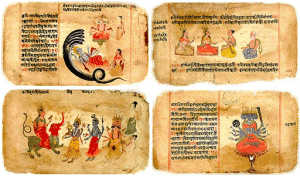
> YOGA & LIVE SANSKRIT CLASSES <
Śruti (Sanskrit: śrúti, „hearing, listening“) is a term that describes the sacred texts comprising the central canon of Hinduism and is one of the three main sources of dharma and therefore is also influential within Hindu Law. These sacred works span the entire history of Hinduism, beginning with some of the earliest known Hindu texts and ending in the early modern period with the later Upanishads.. Śruti is often cited as akin to the Vedas; however, it also contains various supplementary commentaries on them. This literature differs from other sources of Hindu Law, particularly smṛti or “remembered text”, because of the purely divine origin of śruti. This belief of divinity is particularly prominent within the Mimamsa tradition. The initial literature is traditionally believed to be a direct revelation of the “cosmic sound of truth” heard by ancient Rishis who then translated what was heard into something understandable by humans.
Smṛti (Sanskrit: स्मृति), literally „that which is remembered,“ refers to a specific body of Hindu religious scripture. Smṛti also denotes non-Shruti texts and is generally seen as secondary in authority to Shruti. The literature which comprises the Smriti was composed after the Vedas around 500 BCE. Smriti also denotes tradition in the sense that it portrays the traditions of the rules on dharma, especially those of lawful virtuous persons. This is understood by looking at traditional texts, such as the Ramayana, in which the traditions of the main characters portray a strict adherence to or observance of dharma.
VEDIC PATH – MYTHS OF MEDITATION !
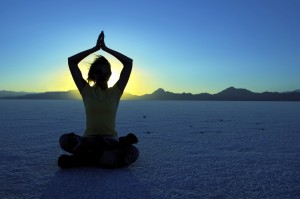
> Myths of Meditation! New light on Dhyana. <
By Yogi Baba Prem Tom Beal, Veda visharada, CYI, C.ay, C.va,
Upanishad
From Hindupedia, the Hindu Encyclopedia www.hindupedia.com
By P.R.Ramachander
The term > „Upanishad“ < literally means the inner or mystic teaching. It is derived from upa (near), ni (down) and s(h)ad (to sit), i.e., sitting down near, which refers to groups of pupils sitting near their teacher to learn from him the secret doctrine. In the serenity of forest hermitages, the Upanishad thinkers pondered on the problems of deepest concerns and communicated their knowledge to the capable pupils that sat near them.
Samkara derives the word Upanishad as a substitute from the root sad, ‚to loosen,‘ ‚to reach‘ or ‚to destroy‘ with Upa and ni as prefixes and kvip as termination. If this determination is accepted, Upanishad means brahma-knowledge by which ignorance is loosened or destroyed. The Upanishads are found in the concluding sections of the Vedas and are classified as Vedanta, or the end of the Vedas.
There are five Vedas and each of these five books has several Saaakas (Branches). Each Saaka has a Karma Khanda dealing with the actions to be performed and is made up of Mantras and Brahmanaas. The latter deals with Upasana or meditation and has Aranyakas * inside them for the benefit of those who have resorted to the quiet habitat of the forest to pursue their spiritual quest.
(*Literature in the ancient period was not fuelled by the urge to preserve history but was a complication of experiences and rules of worship. Most of the literature of this period was religious. (a) The Indigenous literature includes the Vedas, the Brahmanas, the Aryankas, the Upanishads, the Epics Ramayana and Mahabharatha, the Brahmashastras, the Puranas. The Buddhist and Jain literature gives knowledge of the traditions prevalent in those periods. The literature of this period are in Sanskrit Pali Prakrit. It gives us a knowledge about music, dance, painting architecture and administration of various kings.)
The Upanishads are found mostly in the Aranyaka section of the Vedas. The five Vedas have 1180 Saaakas and thus there should be 1180 Upanishads. Of these, what exists today is a collection of 108 Upanishads. The list of these 108 Upanishads is given in the Mukthikopanishad.
Out of the 108 Upanishads, only 10 have been commented upon by several Acharyas like > Adi Shankaracharya < . These are Ishavasya, Kena, Katha, Aithreya, Brihadaranyaka, Prashna, Mandukya, Taittireeya, Chandogya and Mundaka. These have also been popularized by many savants like Swami Vivekananda, Swami Chinmayananda etc. They all deal with highest category of philosophy and metaphysics. Because of this, there is a general impression that all Upanishads are texts of Hindu Philosophy. This is not true. There are Upanishads which even tell you how to wear the sacred ash, how to worship a particular God and so on. But the majority of them deal with methods of Yoga and Renunciation (Sanyasa).
Dhyana Bindhu Upanishad
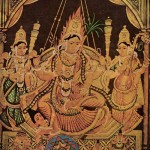
Om ! May He protect us both together; may He nourish us both together;
May we work conjointly with great energy,
May our study be vigorous and effective;
May we not mutually dispute (or may we not hate any).
Om ! Let there be Peace in me !
Let there be Peace in my environment !
Let there be Peace in the forces that act on me !
THE SACRED SYLLABLE „OM“ ACCORDING TO THE UPANISHADS (including dhyana bindu upanishad) , by TYS, Tradtional Yoga Studies, Georg Feuerstein, : > here < .
Aum (also Om, written in Devanagari as ॐ, in Chinese and Japanese as 唵, in Tibetan as ༀ, in Sanskrit known as praṇava प्रणव lit. „to sound out loudly“ or oṃkÄ�ra ओंकार lit. „oṃ syllable“) is a mystical or sacred syllable in the Indian religions, including Hinduism, Sikhism, Jainism and Buddhism, and in Bön.
Aum is commonly pronounced as a long or over-long nasalized close-mid back rounded vowel,) though there are other enunciations pronounced in received traditions. It is placed at the beginning of most Hindu texts as a sacred exclamation to be uttered at the beginning and end of a reading of the Vedas or previously to any prayer or mantra. The Mandukya Upanishad is entirely devoted to the explanation of the syllable. The syllable is taken to consist of three phonemes, a, u and m, variously symbolizing the Three Vedas or the Hindu Trimurti or three stages in life ( birth, life and death ). Though ostensibly in some traditions it is polysyllabic and vocalized as a triphthong, the Omkara is held to move through and contain all vowels possible in human speech.
The name Omkara, (Sanskrit: the syllable om) is taken as a name of God in the Hindu revivalist Arya Samaj. Similarly, the concept of om, called onkar in Punjabi, is found in Sikh theology as a symbol of God. It invariably emphasizes God’s singularity, expressed as Ek Onkar („One Omkara“ or „The Aum is One“), stating that the multiplicity of existence symbolized in the aum syllable is really founded in a singular God.
Read the full text: > HERE <
> Meet Adi Shankara Group at facebook <
LAMA JIGME´s FREE TIPS ON MEDITATION

FREE tips and teachings on Meditation and the Spiritual Path.
How could you help Feed a Buddhist Monk for just One dollar?
Please click > HERE < to learn how
Lama Jigme a refreshing encounter Episode Lama Jigme Gyatso is an ordained monk in an age when many are content to hide behind tradition, hearsay, dogma and circular reasoning it can be refreshing to encounter someone like him. Taking his teachers instructions to heart, he practices and transmits the Buddhas teachings in an essentialized and pragmatic manner that is as profoundly effective as it is deeply practical.
Who is Lama Jigme ?
Ordained as Lama Jigme Gyatso: Rime Manipa Tantrika, which translates as “Ocean of Courage Teacher; ” he is a Jewish-american born, Tibetan-buddhist: Monk, Teacher, Healer and Tantrika.
Lama Jigme was taught to be devoted to the Buddha of Compassion {Manipa} in a NON-sectarian manner {Rime} that practices Sutra’s union of compassion and insight as well as the union of Tantra’s paths of devotion, imagination and sensuality {Tantrika}.
In an age when many are content to hide behind tradition, hearsay, dogma and circular reasoning this controversial and unconventional teacher insists that a true Lama’s resume, credentials and letters of recommendation are the vastness of his Compassion, the profundity of his Insight and the power of his Effectiveness.
Lama Jigme Gyatso has had the very good fortune to receive teachings from every major Buddhist lineage of the Theravada, Mahayana and Tantric traditions.
Taking his Lama’s instructions to heart, he practices and transmits the Buddha’s teachings in an essentialized manner that is as profoundly effective as it is deeply practical.Interessen:Lama Jigme is playful and dynamicas well as loving and insightful.
Just as the alchemists of legend turned lead into gold, instructions received from this precious teacher can transform sorrow, anger, and fear into peace, love, joy and bliss.
Grounding Techniques – one way to reduce stress & anxiety
> LIVING BY DESIGN, ANANGA´s BLOG <
> FREE: Beautiful Calm eBook <
Ananga Sivyer is a health writer with a passion for helping people feel positive and in control of their lives. She’s a contributing health editor for Lifescape Magazine and the author of the self-help workbook The Art & Science of Emotional Freedom.
She is currently enjoying writing for this blog while studying Ayurvedic Medicine.
Ananga is also a musician, she plays the flute and records projects for relaxation and meditation. She has worked with New World Music’s leading artists Pia and John Richardson and composed the music for Silvia Hartmann’s HypnoDreams and HypnoSolutions. She released Beautiful Calm a collection of guided meditations in August 2007 and is presently working on new relaxation projects, find out more in the new Inner Calm Audio Store.
Read Self Help Tree’s interview with Ananga about her meditations > here<
Relaxation & Meditation Downloads:
Guided Meditation downloads
Meditation classes to go – master your breath, calm your mind and lift your mood…
meditation download view selection:
Music for Relaxation
Music for relaxation and contemplation featuring traditional ethnic meditation instruments.
Yoga Meditation Music
Set the mood for your yoga or meditation practice with this soothing background music featuring the sounds of nature, flute and sitar to calm your mind and soothe your spirit
Alpha Brain Audio
Alpha brain relaxation music for whole brain creative thinking & problem solving..
Grounding Techniques
Quick and easy grounding techniques for reducing stress and anxiety…
Forest Temple Music for Yoga & Meditation:
Among the trees of an ancient forest you find a temple, small and safe, a bare wood floor and a cushion await you within it’s stone carved walls. The birds sing, as they have always done here, and the rain drips softly on the leaves outside the door.
Featured Meditation & Relaxation Titles:
Spread the Calm as an Inner Calm Audio Affiliate
Qualifications:
- Ananga is a Licensed Practitioner & Trainer with The Association For Meridian Energy Therapies the UK’s leading organisation for teaching EFT & Meridian Therapies
- Certified Practitioner of NLP: Neuro-Linguistic Programming
- Certified Practitioner of Humanistic Neuro-Linguistic Psychology
- Certified Practitioner of TimeLine Therapy
- Stage 1 Hypnotherapist Practitione
- Student of Ayurveda
> Meet living by design at facebook <
BIOGRAPHY OF RAMAN MAHARSHI.
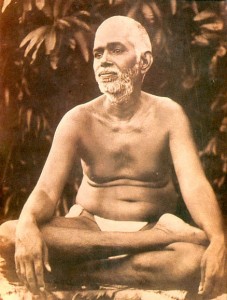
www.sriaurobindosociety.org.in
The Self alone exists; and the Self alone is real. Verily the Self alone is the world, the I-I and God. All that exists is but the manifestation of the Supreme Being. – Ramana Maharshi
Ramana Maharshi was born on 26th Dec in the year1879 in Tiruchhulli near to Madurai in South India. For the first 16 years of his life he was a normal child, with a keen interest in his studies and sports. However at a certain point he became struck with an unusual, yet overwhelming fear of death. Lying in his own room he became acutely aware of the inevitability of death and the mortality of his own body. However this paralysing fear proved to be only transient. With another penetrating insight he became aware that “I am not the Body” The real “I” was beyond matter. He was not a body but spirit. It was just that up until that point he had ignored this “I” or inner self.
With this glimpse of a higher, immortal consciousness the Maharshi lost all interest in his worldly life, he was plunged into a period of intense meditation on the nature of “Who am I” Absorbed in contemplations of a higher consciousness Ramana no longer felt any reason to stay in his home town. Instead he was magnetically drawn to the holy mountain of Arunachala, whose name alone, held a mantric appeal to Ramana Maharshi . Arunachala was to become the home for Ramana Maharshi for the rest of his life and the mountain was to be inexorably linked to his own sadhana and self.
For several years Ramana maintained a virtual silence because he was so absorbed in his interior meditations. Despite leading the most simple of lives and barely communicating, a group of devoted seekers began to be drawn to the mystical aura of this young sage. Thus gradually an ashram was built around him on the foothills of Arunachala and Ramana Maharshi would start to teach those who came, although he never claimed to be anybody’s Guru. After 2 years his mother came to visit Ramana, tearfully pleading with him to return home. Despite this Ramana was unmoved maintaining a calm meditative expression. Finally he answered that sometimes a higher power controls the fate of men and whatever she said could not change his destiny. (After her other children died several years later, his mother would return and eventually became a devoted disciple of her own son and remained in Arunachala for the last 6 years of her life)
Ramana Maharshi had no formal training in Yoga, he was entirely self taught, receiving only guidance from his own inner pilot, but so unique and powerful were his teachings that learned men well versed in scripture became disciples of Ramana Maharshi. Ramana Maharshi taught a simple path of self inquiry along the lines of “Who I am” He guidance sadhaks to train their awareness to the source of their thoughts – to their own inner self. Because of this Ramana Maharshi was often viewed as a Jnani (Man of knowledge) however he also had a strong devotional aspect, that is evident in some of his poems
“Thou madst me mad to cure me finally
Of madness for this world of fantasy.
“As a spider thou wouldst watch me, Lord,
To trap me in thy web of Grace
Till now, when I’m enmeshed, thou com’st
And feed’st on me, O Blessedness!”
(Translated from the original Sanskrit, entitled Five Hymns)
Ramana Maharshi was compassion and forgiveness incarnate. There is a story told that once burglars came to the ashram. They were so incensed there was nothing worth stealing that they started to hit Ramana. However the great Sage displayed no sense of anger, he even offered the burglars some food before they left. (A year later they were caught for similar crimes and sent to jail) Ramana only felt pity for their state of ignorance.
Ramana Maharshi also had a wonderful relationship with animals. Many wild animals such as Tigers and snakes roamed the mountain side but the Maharishi never showed any signs of fear and often befriended animals who came in contact with him. A disciple recorded that on one instance a black cobra entered a hut where the Maharshi was staying, the snake stopped and stared into the eyes of Ramana, after a while the snake retreated. A realized soul maintains a close oneness with all of God’s creation and this compassion can sensed by the animals themselves. The ability to befriend animals is some what reminiscent of St Francis of Assissi who had a similar touch with animals.
Sri Aurobindo said that Ramana Maharshi’s tapasya (spiritual practice) was a shining light of India. Many seekers benefited from his spiritual aura of peace, enabling sadhaks to attain a higher state of consciousess.
Dilip Kumar Roy, a disciple of > Sri Aurobindo < , spent 5 days at Arunachala and had the opportunity to meditate and meet with the Maharishi.
“I saw indeed a man who, outwardly, was anything but distinguished, still less handsome or captivating, and yet.. how shall I put it… he was so compelling, so disarming… And then what peace I felt!
Sri Ramana Maharshi taught a simple path of self enquiry along the ideas of “Who am I?” He could be dismissive of complex metaphysical questions and teasing of those who wanted to solve the problems of the world.
“My friend, when you are in abysmal ignorance about such a fundamental reality as your own self, why waste your time over such monumental metaphysical questions?”
Paul Brunton once asked the sage
“Will the Maharshi express an opinion about the future of the world?”
“Why do you trouble yourself about the future? You do not even know about the present! Take care of the present and the future will then take care of itself.”
Unpeturbed Paul Brunton continued, Ramana Maharshi replied to this my saying,
“ There is One Who governs the world, and it is His look out to look after the world. He Who has given life to the world knows how to sustain it also. It’s He Who bears the burden of the world, not you.”
For the last 2 years of his life the Maharshi suffered from cancer and experienced great physical pain, but even towards the end he maintained the same tranquil poise and self same radiant smile. When he was suffering from cancer in the arm a disciple ran away crying because he could not bear to see his master in pain. Ramana only smiled and spoke to a disciple nearby
“Duraswami is crying because he thinks I am suffering agonies! My body is suffering but I am not suffering. When will he realise that I am not this body?”
Ramana Maharshi attained Mahaparinirvana on 14th April in the year 1950 at the age of 74. An ashram is maintained at Arunachala, his teachings have spread all over the world. He is now widely regarded as being of one India’s foremost Saints of the last century.
> Meet Sri Raman Maharshi Groups at facebook <
> Meet Sri Aurobindo Yoga, School, Ashram, College, at facebook <
